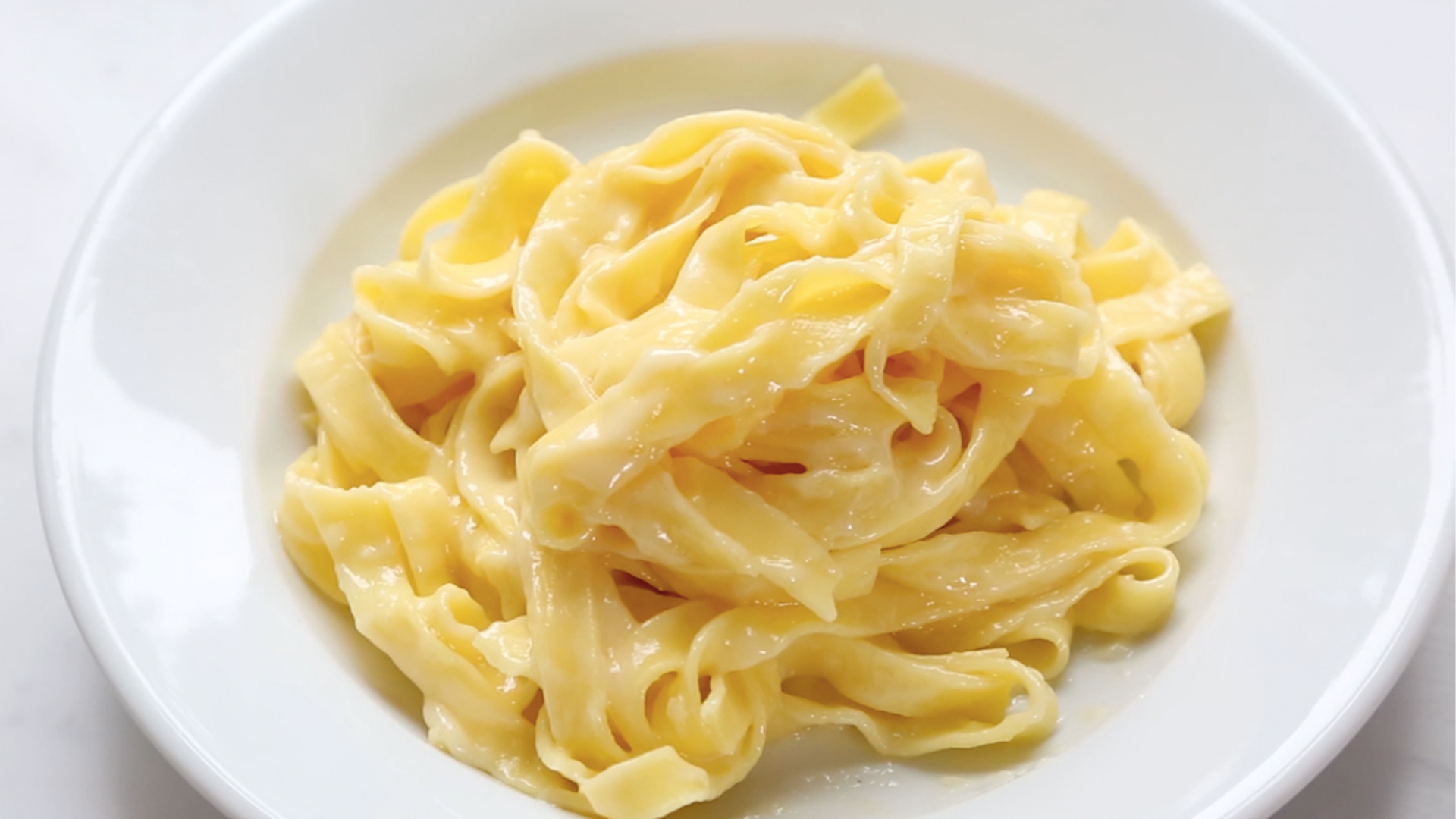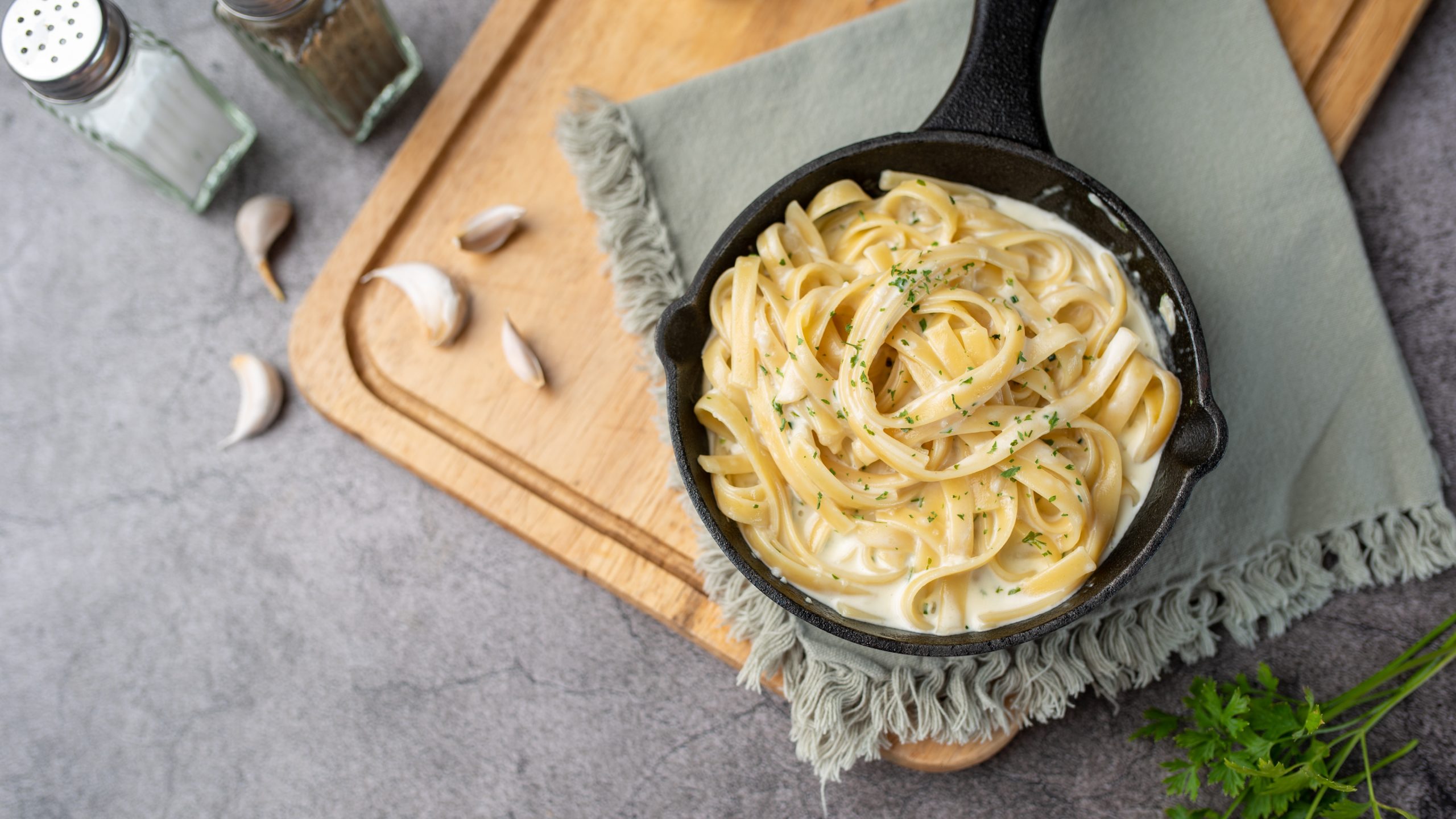Jars of Alfredo sauce can be found in every supermarket in America from national brands like Ragu and Prego, both offering more than one variety of creamy white sauce. Yet, the original Fettuccine Alfredo developed more than a century ago in Rome, started out with just two ingredients: cheese and butter.
A Home Remedy Becomes Restaurant Hit

Italians have long made pasta al burro, or pasta with butter. The old combination dates back to the Renaissance era when fresh pasta was topped with condiments like cheese, pepper, cinnamon, and even sugar. The original recipe for Fettuccine Alfredo was based on Pasta al burro e formaggio, butter, and cheese.
Alfredo Di Lelio owned and operated a restaurant in Rome at the time his wife Ines struggled to recover from the birth of their first son, Armando. Ines was weak from childbirth and found it difficult to eat enough calories without being sick. Alfredo devised a way to fortify her diet while she was recovering.
First, Alfredo began making fresh fettuccine noodles with extra egg yolks. The result was golden-colored pasta. The noodles contained additional calories and protein from the yolks but were still basic enough for Ines to eat.
He then took the dish a step further. He chose butter with a high-fat content combining the butter and pasta in the pan. Alfredo used much more butter than typical– one recipe at the time described it as three lumps of butter the size of eggs. He also grated in cheese chosen from the center of the Parmigiano-Reggiano wheels where the cheese is denser. Mixing this together over heat with a bit of starchy water from the boiled pasta created a sauce with a cream-like texture. His final touch was to add a little extra butter to the plate.
Later versions of Alfredo's creation would be known as pasta al doppio burro, double butter, or triplo burro, triple butter, because of the large amounts of butter added to the pasta while it was made.
Ines recovered and thought the dish Alfredo invented was good enough to add to the restaurant menu. He finally did in 1914.
Fettuccine Alfredo Comes to Hollywood

The world may never have heard of Fettuccine Alfredo had the inventor been an ordinary chef. But Alfredo Di Lelio was more than that. He was a natural entertainer and showman, and to generate excitement for his restaurant, he dazzled patrons with his tableside service.
Alfredo was known as "the Maestro" because he served restaurant guests accompanied by musicians and singers. He mixed the Fettuccine Alfredo tableside, stirring the cheese, butter, and pasta together while the music played. The spectacle began attracting celebrities and politicians, and many would pose for photographs alongside the chefs.
The restaurant also caught the eye of American restaurateur George Rector. Rector and his father had operated large-scale restaurants in New York and Chicago, usually including entertainment in their establishments. But the Volstead Act in 1919 banned the sale of alcohol in America, and the Rectors' restaurants closed. George Rector then became a food writer with a cookbook and columns about restaurants and dining out. On a trip to Rome, he visited Alfredo's restaurant and wrote about it in a 1927 issue of the Saturday Evening Post.
A few months after Rector's column, the film stars Mary Pickford and Douglas Fairbanks were honeymooning in Rome. They too found their way to Alfredo's restaurant, likely, even, on a recommendation from Rector. They adored Alfredo and ate many of their meals in his restaurant. Before leaving, the couple presented him with a golden spoon and fork that he continued to use during the preparation of the dish.
Pickford and Fairbanks brought the recipe home to Hollywood where they often served Fettuccine Alfredo at parties.
Alfredo Sauce at Home

Achieving the fine velvety consistency of a true Alfredo sauce can prove tricky. The cheese must be finely grated and there needs to be enough starch in the residue water from the boiled pasta to create the emulsion. Post-war America was all about convenience foods, and tricky techniques were not something the 1960s home cooked wanted to deal with. Luckily, the Pennsylvania Dutch Noodle Company came up with an easier solution.
Launching a new line of egg noodles, the marketing team behind the Pennsylvania Dutch Noodle company created numerous recipes for their golden fettuccine, such as Beef Stroganoff. One of the recipes was for a Fettuccine Alfredo and included such additional ingredients as Swiss cheese and heavy cream. The extra items made preparing the sauce easier and it set the stage for many variations on the recipe to come.
The Pennsylvania Dutch Noodle company isn't the only recipe to add cream to the classic Alfredo sauce. Marcella Hazan, the Italian-chemist-turned-cookbook-author included cream as an ingredient in her Alfredo recipe. The Classic Italian CookBook, her 1973 collection, includes the recipe and helped introduce Americans to modern, contemporary Italian cuisine.
Chicken Alfredo Is Born

Perhaps the biggest change to Alfredo sauce came in 1982 when Olive Garden launched its first casual Italian-themed restaurant. The restaurant chain was created by the General Mills corporation and Bill Darden, who founded the Red Lobster Chain. Darden had sold it to the conglomerate and was responsible for growing the restaurant division. Looking to expand in the area of restaurants, Olive Garden was the first concept launched by the company.
The original menu of the restaurant included chicken alfredo pasta, a combination of grilled chicken, and a creamy Alfredo sauce topping a plate of pasta. The original recipe can still be found at Olive Garden restaurants around the country and it includes milk, cream, and Romano cheese.
Olive Garden often uses Alfredo sauce in the same way many recipes might use Béchamel, the classic French-style white sauce. Today the chain offers numerous Alfredo-style pastas with seafood and steak.
The shift from a pasta dish into a sauce led to jarred sauce companies offering premade cream sauces. And once the flavors were separated from the pasta, it could be combined with other things like Alfredo pizza, which grew in popularity in the 1990s, often mixed with spinach or artichokes. Chain pizzerias also have started selling Alfredo pizza, and now it's used as base for many other flavors including garlic or herbs.
While Americanized Alfredo sauce might have strayed far from the original, it remains a popular dish available in supermarkets and restaurants all over the world.
Ian MacAllen
Ian MacAllen is America Domani's Senior Correspondent and the author of Red Sauce: How Italian Food Became American. He is a writer, editor, and graphic designer living in Brooklyn. Connect with him at IanMacAllen.com or on Twitter @IanMacAllen.

